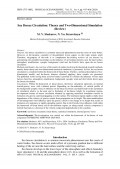Purpose. Sea breeze circulation is a common mesoscale phenomenon near the coasts of water bodies. However, at the moment, a number of the published review papers on this topic remain small. Therefore, the purpose of the work is to complement the existing reviews on sea breezes by generalizing the available knowledge on the influence of air heating intensity near the land surface, atmosphere stratification, synoptic background wind and the Coriolis force upon the sea breeze circulation.
Methods and Results. An overview of the results of studies involving the theoretical research methods, namely linear theory and two-dimensional numerical simulation, is presented. At first, the sea breeze circulation is considered within the framework of linear theory. Further, a technical description of two-dimensional models and the breeze features obtained applying these models are presented. The published works having been reviewed made it possible to consider the influence of four main factors (heat flux, atmosphere stratification, background synoptic wind and the Coriolis force) upon the breeze circulation.
Conclusions. Within the framework of linear theory, the breeze circulation represents an internal inertial-gravity wave with a diurnal period. Depending on the uniformity of vertical profile of the background synoptic wind, its influence on the linear sea breeze circulation leads to the asymmetry of circulation relative to the coast and to limitation of the breeze height. In a nonlinear regime, the important feature of breeze circulation obtained by applying numerical simulation consists in formation of a gravity current propagating over the surface. The nonlinear regime implies a fairly clear dependence of the velocity of gravity current front propagation on its height. The main manifestation of the background wind influence upon the gravity current is the change in its height that results in formation of a stationary or rapidly spreading current. Due to the Coriolis force influence, both within the framework of linear theory and in the nonlinear regime, an along-coastal velocity component is formed that leads to a decrease of the velocity component perpendicular to the coastline.
